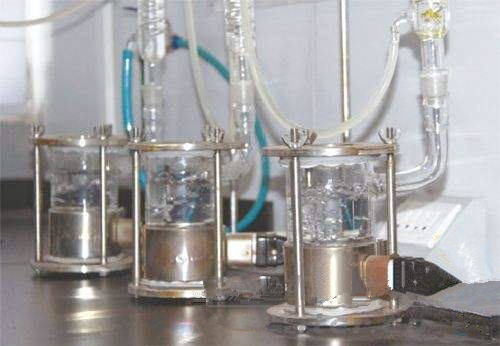Boiling And Hot Water Test for Steel Enamel
1, Boiling test
The boiling test is not only suitable for acid resistance test, but also for alkali resistance test. And the results directly indicate that the porcelain enamel is resistant to acid and alkali after firing, and there are fewer errors caused by other factors.
American ASTM and Japanese JIS have detailed specifications for this test, although they are slightly different, they are roughly the same. The test method is to cut the enamel product into a 0.8cm diameter circular test piece, or to coat a metal test piece with enamel frit and then fire it, and then measure it with the device.
After weighing the test piece, place it in the device. Place various acidic (10% sulfuric acid, 10% hydrochloric acid or 6% citric acid) or alkaline solutions (5% sodium pyrophosphate) in the container, and heat and boil the bottom for a certain period of time (with different types and concentration of the solution). Then take out the test piece, clean and dry, and weigh it. According to our many years of experience, the acid resistance of acid-resistant enamel should be below 0.08mg/cm2.
The acid resistance of most enamels is stronger than the alkali resistance. At present, there are enamel frits that can fully resist 5% sodium pyrophosphate and 2% caustic soda at boiling temperature, and can fully resist alkaline solutions of pH 12 at 100°C.

2, Hot water test
Even with boiling water, prolonged contact has no significant effect on the steel enamel surface. However, under pressure and constant water changes, the enamel will slowly erode over several years.
Hot water tanks must be more resistant to natural water than other enamelware, so experiments on resistance to hot water corrosion must be done. The corrosive power of water on the enamel increases with the temperature rise, about every 10 ℃ increase, the corrosive power doubles, so the temperature of the test must be higher than the temperature used. The usual test methods include boiling test and high temperature autoclave test. The boiling test can use natural water or dilute sodium carbonate solution. Weigh the difference between the weights of the test pieces before and after boiling to obtain the amount of water erosion.
In the autoclave test, the enamel test piece is placed in the autoclave together with water, and then heated to above the boiling point of the water. The temperature and pressure in the autoclave rise at the same time, so it can be expressed by any measurement. Most enamels can be seen to be corroded within 24 hours under 22kgs. pressure (146.5℃), and some enamels can withstand several days under 86kgs. (195℃).